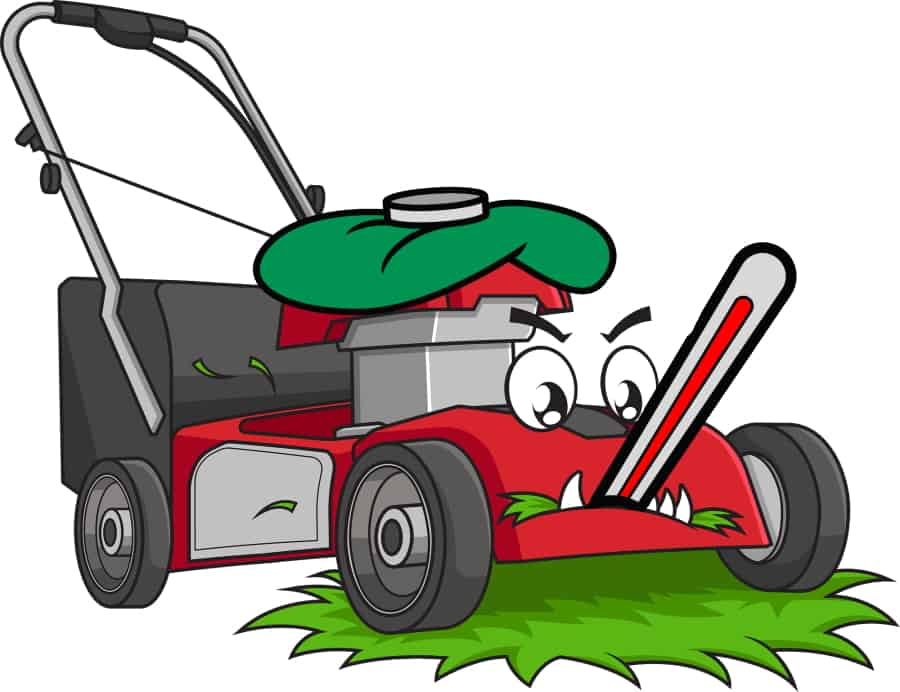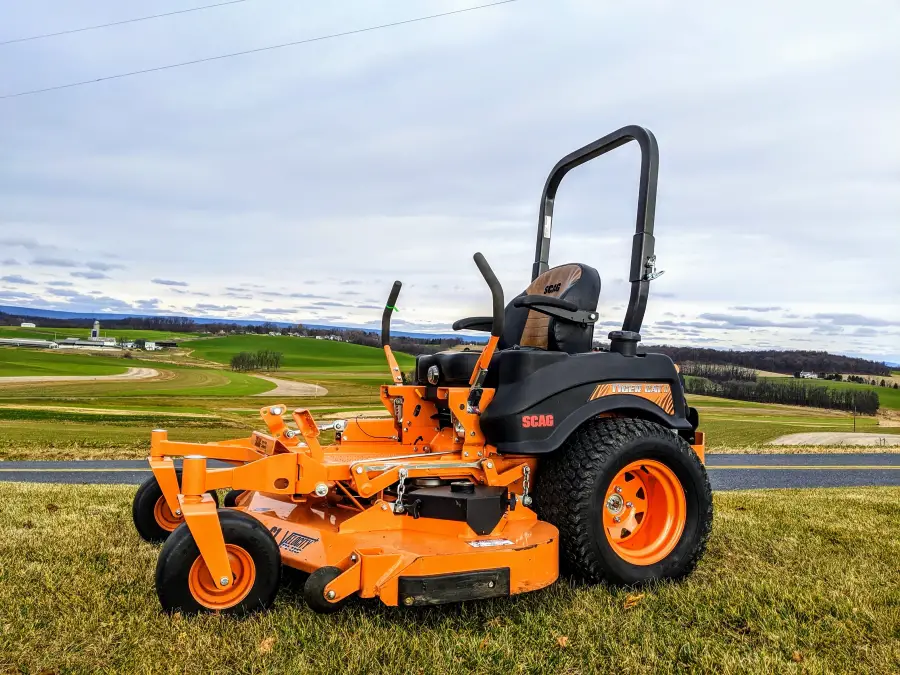SCAG is one of the most popular lawnmower brands in the world, and for good reason. SCAG mowers are renowned for their toughness, build quality, and elite cutting prowess, qualities that the average customer is always looking for.
SCAG mowers have problems despite being some of the most reliable and popular mowers on the market. Though rare, they do experience driveshaft issues, hydraulic system problems, and infrequent instances of backfiring. Even quality built machines are not immune to some challenges.
Unfortunately, some of the brand’s machines may have certain issues that impede function, performance, or operator comfort. We’re here to point out some of these problems, and any potential solutions, to inform prospective customers before they commit to a potentially expensive liability.
Though SCAGs are excellent machines, informed decisions make happy mower owners.

Contents
Is SCAG A Good Brand Of Mower?
Now, we must start by saying that, generally speaking, SCAG mowers are excellent machines. Commercial machines like the Turf Tiger II and Patriot are class-leading zero-turn mowers with loads of innovations like the Hero Cutter Deck, which is made up of 2 steel plates, and the triple-plated Velocity Plus Cutter Deck.
We also love the operator comfort on offer. You get adjustable seats, cup holders, armrests, as well as foot pedals for braking and blade engagement on some models. The controls are easy to learn and the quality of the deck, blades, and spindles allows beginners to produce professional-grade cuts every time.
Another great thing about SCAG is the optional extras and accessories. For the Turf Tiger II, for example, you get to choose between a 52, 61, or 72-inch Velocity Plus Deck as well as the type of fuel you want to run. There are gas engines from Kawasaki and Briggs, diesel engines from Kubota, and propane engines from Kohler.
Accessories for the Turf Tiger include the SCAG Hurricane Plus Mulch System (mulch plates and blades), operator-controlled discharge chute (OCDC), an air filter monitor, and SCAG’s impressive 3-bag grass catcher…just to name a few.
Prices for SCAG z-turns range from about US$5,500 for an entry Liberty Z to nearly $24,000 for a 72-inch diesel Turf Tiger II. The V-Ride II standing mower has a top-end price of nearly $14,000. Walk-behind mowers range from about $3,000 (SFC) to over $10,000 (SWZ Hydro-Drive).
Naturally, extras, accessories, location, shipping costs, and other factors will influence the final MSRP.
SCAG also provides reasonable warranties for its products. Engine warranties, however, are the responsibility of the engine manufacturer.
The Liberty Z has a five-year (or 750-hour) private use warranty and no commercial warranty. The Patriot has a 3-year (500-hour) private-use warranty and a 2-year commercial warranty. Machines like the Turf Tiger II and V-Ride II have 2-year commercial warranties, 3-year (500-hour) private-use warranties, as well as 3-year cutter deck and spindle warranties.
All SCAG mowers also have 90-day rental and wear item (belts, blades, tire, battery, etc.) warranties as a buffer against defects.
Do SCAG Mowers Hold Their Value?
Quality built machines with good reputations will normally hold their value better than others. SCAG fits squarely into this category. So, does this still hold true? Do SCAGs keep their value over time?
SCAG mowers definitely hold their value over time more than many other brands. You can reasonably expect a well maintained SCAG to still sell for a used price upwards of 50% to 60% of the original sale amount. There are other comparable brands, but none that drastically outperform a SCAG.
Much of this has to do with brand reputation. Yet, this reputation would not exist without a strong track record of long lasting and quality performance.
SCAG is known in the lawn care industry as a trusty workhorse that can be relied upon for many years. Though they are not the cheapest machines on the market, if they were it would make many skeptical of its accolades.
If you are planning on buying a new or used version of a SCAG mower, you can do so with confidence that it will be money well spent.
What Problems Are Owners Having With SCAG Mowers?
So, what defects can a SCAG mower be harboring? There are a few minor ones and one major issue that should be kept in mind.
Though SCAG mowers are some of the top of the line mowers in the lawncare industry, no manufactured product will be completely without defects and problems. SCAGs tend to have minor driveshaft issues, more substantial hydraulic problems, and some backfiring occurrences.
Let’s look at each of these a little closer.
SCAG And Driveshaft Issues
Various owners over the years have reported driveshaft problems, particularly with older SCAGs. That said, these issues are extremely rare and they are virtually unreported for the current lineup of SCAG mowers. The company’s continued production of shaft-driven machines is further evidence that consumers needn’t worry about this particular “problem”.
Hydraulic Problems On SCAG Mowers
One problem that prospective customers should pay attention to is hydraulic issues. A hydraulic system is comprised of a hydro pump, hydraulic fluid reservoir, valves, and hoses that facilitate liquid circulation. Any of these components can develop problems.
Although these issues are also rare, reports have been much more common than those regarding driveshafts. From malfunctioning pumps to leaking hydraulic fluid, the issues are frequent enough to raise concern, especially given the price of a mower bearing the SCAG logo.
Many owners report witnessing puddles of hydro fluid where they park their mowers. This is usually a consequence of hydraulic seals being worn out. Hydraulic systems need to be completely airtight because the fluid is at extremely high pressure levels. The continual motion of hydraulic components contributes to the wear on seals, which results in a leak.
Hydraulic pumps also fail for several reasons. Air contamination is one of the most common causes. If air enters the hydraulic system, it can cause one of two problems: aeration or cavitation.
Aeration, in simple terms, is when external air enters the system (usually through a compromised valve seal), and wreaks havoc. This air then circulates through the hydro system as air bubbles, which affects performance. This problem may also cause the hydro pump to make nasty “knocking” noises.
Cavitation is a little different. This is when dissolved air that is found in hydraulic fluid is pulled up by the pump. This can cause a series of implosions that can seriously harm the pump and compromise the overall system.
In addition to air, you also need to worry about water contamination. Drastic temperature shifts can result in condensation in the hydro hoses. This water can cause problems by oxidizing certain components or even freezing. One sign of water damage is milky white hydro fluid.
Depending on the warranty status, the manufacturer will take care of these hydraulic issues and make appropriate replacements. SCAG is no stranger to under-warranty pump replacements.
A tip for avoiding air and water contamination is to frequently replace hydraulic fluid, especially if the mower is used a lot. At the same time, we strongly recommend draining hydraulic fluid if you won’t be using the mower for a long time. If you are storing your mower for a move or the winter, you have to drain all the hydraulic fluid.
The hydraulic fluid can also be seriously affected by temperature. High heat (in the mower or surrounding environment) can result in the aforementioned oxidation. Heat can also cause thinning of the hydro fluid, which increases the likelihood of leaks.
Inversely, cold conditions can cause the fluid to thicken. Thick fluid won’t circulate efficiently and could even form sludge around vital components, resulting in malfunctions. Thickened fluid also has a greater chance of releasing its dissolved air, which can lead to cavitation.
Hydro problems vary, so the best way to diagnose issues in this area, particularly if you are off warranty, is a troubleshooting guide. This should include a thorough inspection of motors, pumps, valves, and seals. You should also monitor fluid levels and check for viscosity and thickness.
Why Does My SCAG Mower Backfire?

Another problem that occasionally haunts combustion mowers from any brand is the dreaded backfire.
Just like with hydraulic problems, backfiring can have several different causes.
Air Filters Can Cause Backfiring
One of the most common causes is a compromised air filter. Air filters accumulate a lot of dust and debris over time, which hinders airflow to the combustion chamber. As you know, combustion requires oxygen, and if there isn’t enough of it, combustion will be weak. This results in sputtering and backfiring.
Oil And Backfiring
Another cause is lack of oil or degraded oil. Oil is responsible for lubricating moving parts in the engine like the crankshaft and cylinders. Without it, friction occurs, which affects how smoothly your mower runs. Oil can lose its lubricative qualities over time, or it can leak out due to damage and wear.
Older Fuel Can Be An Issue
Aged fuel is also a problem, particularly for mowers that are stored away for extended periods. As fuel ages, it undergoes chemical reactions that reduce its combustibility. Like with reduced oxygen, the combustion cycles will be inconsistent.
Fuel Systems
The fuel system (fuel tanks, fuel filter, lines, carburetor) is also prone to blockages and disruption, which affects fuel delivery to the engine. The carburetor and fuel filter are especially vulnerable and need to be inspected periodically.
Spark Plugs Are Prime Culprits In Backfiring
Another key element in the combustion process is the sparkplug. This is responsible for adding a spark to the fuel-air mix in the combustion chamber, which triggers an explosion. With time, a sparkplug can get worn out or dislodged from its position, resulting in misfires.
All of these problems are related to maintenance and service. Proper service includes the replacement of air and fuel filters, changing sparkplugs, and changing oil. Fuel should also be drained from the tank if you will be storing the mower away for the winter.
You should also try to mow the grass while it is dry. While SCAGs are famous for their prowess with wet grass, this may strain your machine’s engine over time.
The Final Touches On SCAG Problems…
With all of these potential issues mentioned, it is important to note that SCAGs are some of the most respected and relied upon mowers in use today. Any machine will have a track record spotted with at least occasional issues. SCAG is no exception.
Understanding that problems can happen, SCAGs reputation assures owners and prospective owners that they can be relied upon more than many of their competitors. The chances of problems with one of their mowers is much less than some others on the market.
References
https://www.scag.com/product-category/zero-turn-riding-mowers/
